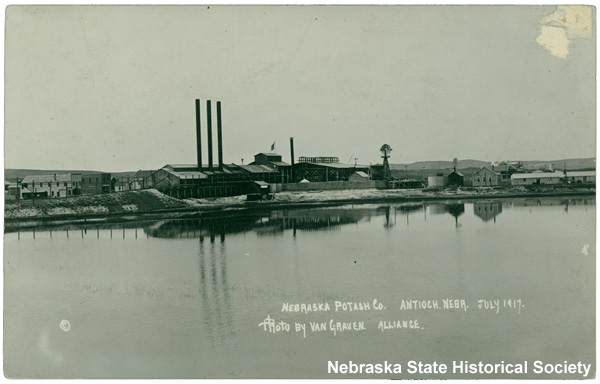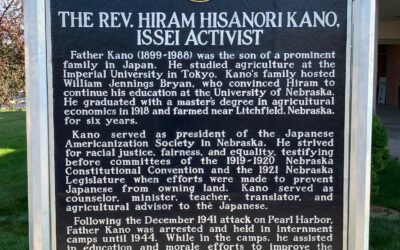 The ruins of the potash plant at the former town of Hoffland, Sheridan County, Nebraska, July 9, 1955. NSHS RG2541-6-31
The ruins of the potash plant at the former town of Hoffland, Sheridan County, Nebraska, July 9, 1955. NSHS RG2541-6-31
Highway 2 through the Sandhills is one of Nebraska’s most scenic drives. Deep in the Sandhills lakes country, near the tiny town of Antioch, stand desolate, oddly-shaped concrete ruins visible from the highway—as if Antioch had once been a much larger city, or home to some inexplicably large enterprise. And that’s pretty much what happened during World War I when Antioch became a potash boomtown.
Potash is a potassium compound that was used as a fertilizer additive, especially in the Cotton Belt. It was also used to manufacture various products such as glass and soap. Before World War I, the U.S. imported most of its potash from Germany. Normally it sold for $8 to $10 a ton, but during the war the price soared to more than $150 a ton. When alkaline lakes in the Sandhills were discovered to have potash, a new industry was soon underway, resulting in ten huge plants that could each produce a hundred tons of potash per day.
 “Nebraska Potash Co. Antioch, Nebr. July 1917 Photo by Van Graven Alliance.” NSHS RG2541-1-7
“Nebraska Potash Co. Antioch, Nebr. July 1917 Photo by Van Graven Alliance.” NSHS RG2541-1-7
The lakes were on state-owned school land that was leased to a private company, and rumors spread of favoritism and dirty dealing. The Nebraska state land commissioner and the secretary of state responded with a press release in which they stated that they would tolerate no delays in the project because “our country needs the product for munitions.” That was false—potash wasn’t used in munitions—but the story was widely believed and tended to shield the project from criticism. (“So much for patriotism,” complained the Alliance Semi-Weekly Times after debunking the press release.) In true boomtown fashion, the Sandhills potash industry rose and fell quickly. Various companies struggled for control of the industry, but the war’s end re-opened the import market and the Nebraska plants were soon priced out of business. Their ruins stand as a testimony to the wide-ranging and unpredictable effects of war and international commerce. Richard Jensen describes the potash boom in a 1987 Nebraska History article (PDF). A National Register of Historic Places nomination (PDF) also describes the site’s history and its remaining structures. And if you’re driving Highway 2, look for a historical marker west of Antioch.



